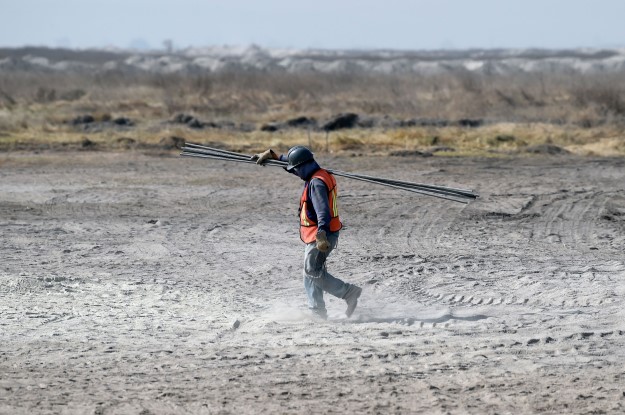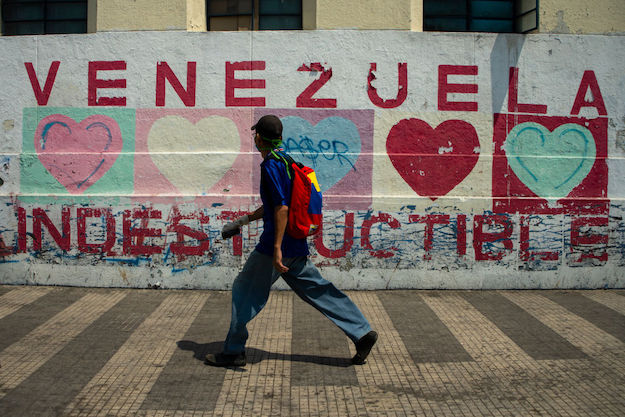As protests continue in Venezuela, the government of President Nicolás Maduro has sought to delegitimize protests and isolate them in middle-class areas in the hope that they will burn out.
The president’s rhetoric aims at inciting poorer citizens against student and middle-class protesters, who he blames for food shortages, and soaring inflation and by “sabotaging the economy.” He calls protesters “fascists” who are organizing a “soft coup.”
This is a risky strategy. Though reports of relative calm in barrios remain accurate, acts of protests do take place there—such as youth setting up barricades on a hit-and-run basis, and residents banging pots to protest shortages (cacerolazos). Significant numbers of poor youth also unite in Caracas’ barrios every night to join middle-class youth confronting the National Guard.
As a result, the Venezuelan government has realized that it needs to alleviate shortages in barrios, and has urgently sought Russian—and especially, Chinese—loans to float reforms. Now, with the launch of the country’s third and newest foreign exchange system on Monday, Maduro is betting on a new economic strategy to contain protests.On March 8, Rafael Ramírez, the president of Petróleos de Venezuela S.A. (PDVSA) and vice president of economics for the Consejo de Ministros (Council of Ministers), announced that he had secured extraordinary loans totaling $7 billion from China and Russia. China’s $5 billion loan is to be repaid with oil (Ramírez claimed that this will not increase exports to China), while Russia’s $2 billion loan is intended to develop a Russian-PDVSA Faja heavy-oil field.
Shortly thereafter, Ramírez announced that the Sistema Complementario de Administración de Divisas 2 (Ancillary Foreign Currency Administration System—Sicad 2), the new dollar market that had been promised since President Hugo Chávez’ death over a year ago, would open on March 24—with very liberal rules and a “free supply of foreign currency,” that Ramírez said the government will help supply.
In September 2013, Beijing refused to loan money to float Sicad 2—reportedly cutting off Maduro and Ramírez’ Powerpoint pitch midstream. So, why did Beijing later approve $5 billion?
The realities of the global oil market, including increased oil production in the U.S. and Canada, guarantee that China will increasingly be Venezuela’s oil-trading partner, no matter who is in power.
However, if protests in Venezuela get out of control, there is little evidence that either chavismo or the factionalized opposition could quickly stabilize the country or the oil sector. This would be problematic for China’s loans and its investments, both in Venezuela and at home. China is building the country’s largest refinery in Guangdong as a joint China National Oil Company (CNPC)-PDVSA project, as well as ships and pipelines towards substantial vertical integration between Venezuela’s oil sector upstream and China’s downstream.
The loan reflects Beijing’s rational concerns that protests could get out of control. However, it has only agreed to the loan under the rubric of the Fondo Chino (Chinese Fund), where loans must be repaid with oil—a more restrictive rubric than Maduro and Ramírez had asked for previously.
But, there is likely another reason behind the loan. Beijing has made demands on chavismo in recent years to improve its financial transparency, discipline and accountability. It is not clear if the liberal rules for Sicad 2 were demanded by China, or if they came at the initiative of Caracas. Either way, they would be judged positively in Beijing.
The Chinese and Russian loans have resolved the first reason behind Sicad 2’s delay: the Venezuelan Central Bank’s dwindling supply of dollars. However, another reason for the delay was a lack of administration consensus on its rules. The very liberal policy now announced is clearly a blow to the old commandist economics of Hugo Chávez and his mentor, former Finance Minister Jorge Giordani. Clearly, the protests compelled this liberal reform.
Although analysts like Miguel Octavio, a Caracas trader, believe that Sicad 2 has overly complex rules, it is, de facto, a much-needed devaluation. Economist Francisco Rodriquez of the Bank of America said that “If the government is effectively channeling dollars that were previously used in the Cadivi or Sicad 1 systems and selling them at a higher rate, this would allow it to reduce its budget deficit and they would have to print less money.”
Meanwhile, the Comisión de Administración de Divisas (Commission for the Administration of Currency Exchange—Cadivi) will still offer subsidized dollars at 6.3 bolivares per dollar, and Sicad 1 will still offer 11.8 bolivares per dollar. Businesses importing certain “necessities” and others approved by the state will get these rates. For example, PDVSA recently promised foreign oil companies that they will be able to obtain dollars at the more favorable Sicad 1 rates. On the first day of the Sicad 2 system, the price for dollars varied between 50 and 55 bolivares.
On March 10, Maduro also announced food rationing, using citizen’s identity cards to limit shopping frequency. While this merely manages scarcity and will be resented, it can limit the reselling of subsidized goods abroad—especially to Colombia—that exacerbates shortages.
It remains to be seen if Sicad 2 plus rationing will rapidly mitigate shortages felt by barrio residents. Clearly, floating the bolivar will reduce PDVSA’s dollar drain and boost potential investor confidence before expected mature-field tenders.
But the present economic measures may instead be too little, too late to prevent barrio residents from being drawn into Venezuela’s protests. In the latter case, the strategy of intensifying repression and counting on demonstrations to burn out, isolated from barrios, could indeed backfire.







